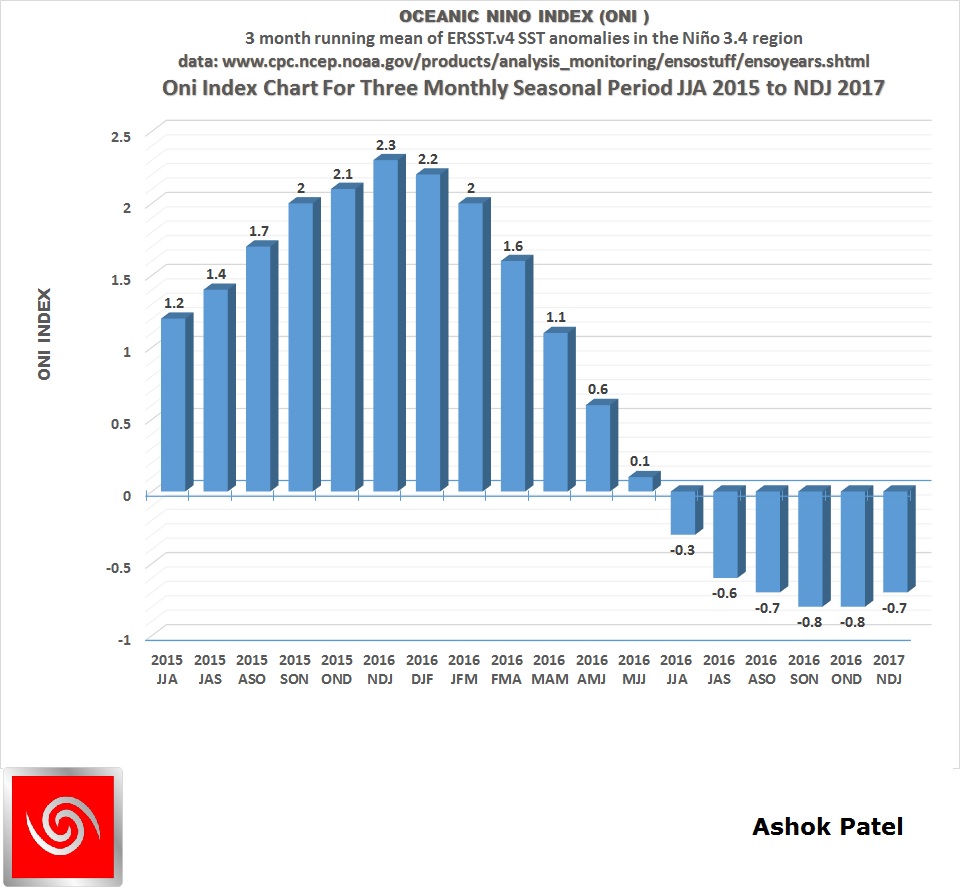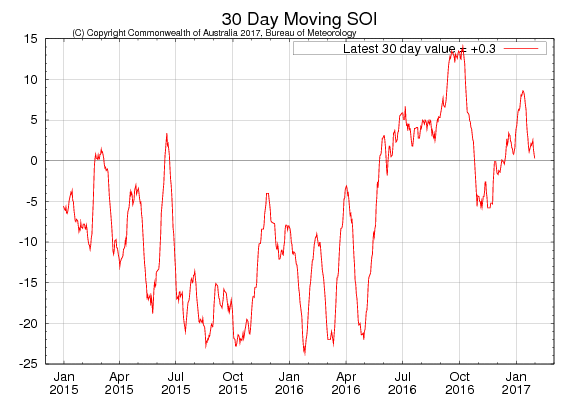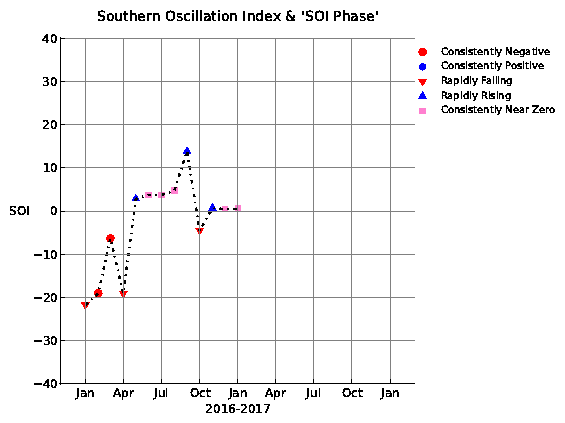ENSO Status on 6th February 2017
The ONI is based on SST departures from average in the Niño 3.4 region, and is a principal measure for monitoring, assessing, and predicting ENSO. Defined as the three-month running-mean SST departures in the Niño 3.4 region. Departures are based on a set of improved homogeneous historical SST analyses (Extended Reconstructed SST – ERSST.v4). The SST reconstruction methodology is described in Huang et al., 2015, J. Climate, vol. 28, 911-930.
CPC uses current Climatology based on 1986-2015 which has been changed late last year from base years 1981-2010. Explanation about Climatology base years change is given here.
NOAA Operational Definitions for El Niño and La Niña El Niño: characterized by a positive ONI greater than or equal to +0.5ºC. La Niña: characterized by a negative ONI less than or equal to -0.5ºC. By historical standards, to be classified as a full-fledged El Niño or La Niña episode, these thresholds must be exceeded for a period of at least 5 consecutive overlapping 3-month seasons.
CPC considers El Niño or La Niña conditions to occur when the monthly Niño3.4 OISST departures meet or exceed +/- 0.5ºC along with consistent atmospheric features. These anomalies must also be forecast to persist for 3 consecutive months.
Full fledged La Nina event has been confirmed at the end of January 2017 relying on the official NOAA definition for La Nina, because there are now five 3-monthly seasons JAS 2016 at -0.6ºC, ASO 2016 at -0.7ºC, SON 2016 at -0.8ºC, OND 2016 at -0.8ºC & NDJ 2017 at -0.7ºC having La Nina threshold. There is a variation of ONI index by 0.1 C in one instance as reported by CPC at the source cited.
Latest Oceanic Nino Index (ONI) Graph Confirming La Nina Event at end of January 2017
The Table below shows the monthly SST of Nino3.4 Region and the Climate adjusted normal SST and SST anomaly for last two years. Climate Base 1986-2015.
Period Nino3.4 ClimAdjust YR MON Temp.ºC Temp.ºC ANOM ºC 2015 1 27.22 26.61 0.61 2015 2 27.25 26.80 0.45 2015 3 27.79 27.32 0.47 2015 4 28.59 27.86 0.73 2015 5 28.83 27.98 0.85 2015 6 28.70 27.76 0.94 2015 7 28.50 27.37 1.13 2015 8 28.47 27.02 1.45 2015 9 28.62 26.94 1.68 2015 10 28.86 26.91 1.95 2015 11 29.14 26.88 2.25 2015 12 29.04 26.80 2.24 2016 1 28.94 26.61 2.33 2016 2 28.89 26.80 2.09 2016 3 28.87 27.32 1.55 2016 4 28.97 27.86 1.11 2016 5 28.60 27.98 0.62 2016 6 27.82 27.76 0.06 2016 7 26.99 27.37 -0.38 2016 8 26.39 27.02 -0.63 2016 9 26.22 26.94 -0.72 2016 10 26.06 26.91 -0.84 2016 11 25.96 26.88 -0.93 2016 12 26.08 26.80 -0.72 2017 1 26.07 26.61 -0.55
CPC considers El Niño or La Niña conditions to occur when the monthly Niño3.4 OISST departures meet or exceed +/- 0.5°C along with consistent atmospheric features. These anomalies must also be forecast to persist for 3 consecutive months.
Southern Oscillation Index
As per BOM, Australia:
The latest 30-day Southern Oscillation Index (SOI) on 6th February 2017 is +0.2 within the neutral ENSO range. Currently there is a disconnect between SST anomaly and SOI.
Sustained positive values of the SOI above +7 typically indicate La Niña while sustained negative values below −7 typically indicate El Niño. Values between about +7 and −7 generally indicate neutral conditions.
SOI Monthly graph up to January 2017 as per The Long Paddock – Queensland Government.
SOI was -0.31 at the end of January 2017 and -0.57 on 6th February 2017 as per The Long Paddock – Queensland Government.
Summary by: Climate Prediction Center / NCEP Dated 6th February 2017
ENSO Alert System Status: La Niña Advisory La Niña conditions are present.*
Equatorial sea surface temperatures (SSTs) are near-to-below average in the central Pacific Ocean. They are above-average in the eastern Pacific Ocean. A transition to ENSO-neutral is expected to occur by February 2017, with ENSO neutral then continuing through the first half of 2017. *
* Note: These statements are updated once a month (2nd Thursday of each month) in association with the ENSO Diagnostics Discussion, which can be found by clicking here
As per BOM -Australia 31st January 2017
El Niño–Southern Oscillation remains neutral
The El Niño–Southern Oscillation (ENSO) remains neutral, with all ENSO indicators currently within the ENSO-neutral range.
Climate model outlooks indicate the tropical Pacific Ocean is likely to remain ENSO-neutral through the southern summer and autumn. Most models surveyed expect the tropical Pacific Ocean to warm during this period, meaning La Niña is the least likely scenario for winter/spring 2017. It should be noted that model outlooks that span the southern autumn period tend to have lower accuracy than outlooks issued at other times of the year. This means outlooks beyond May should be used with some caution.


